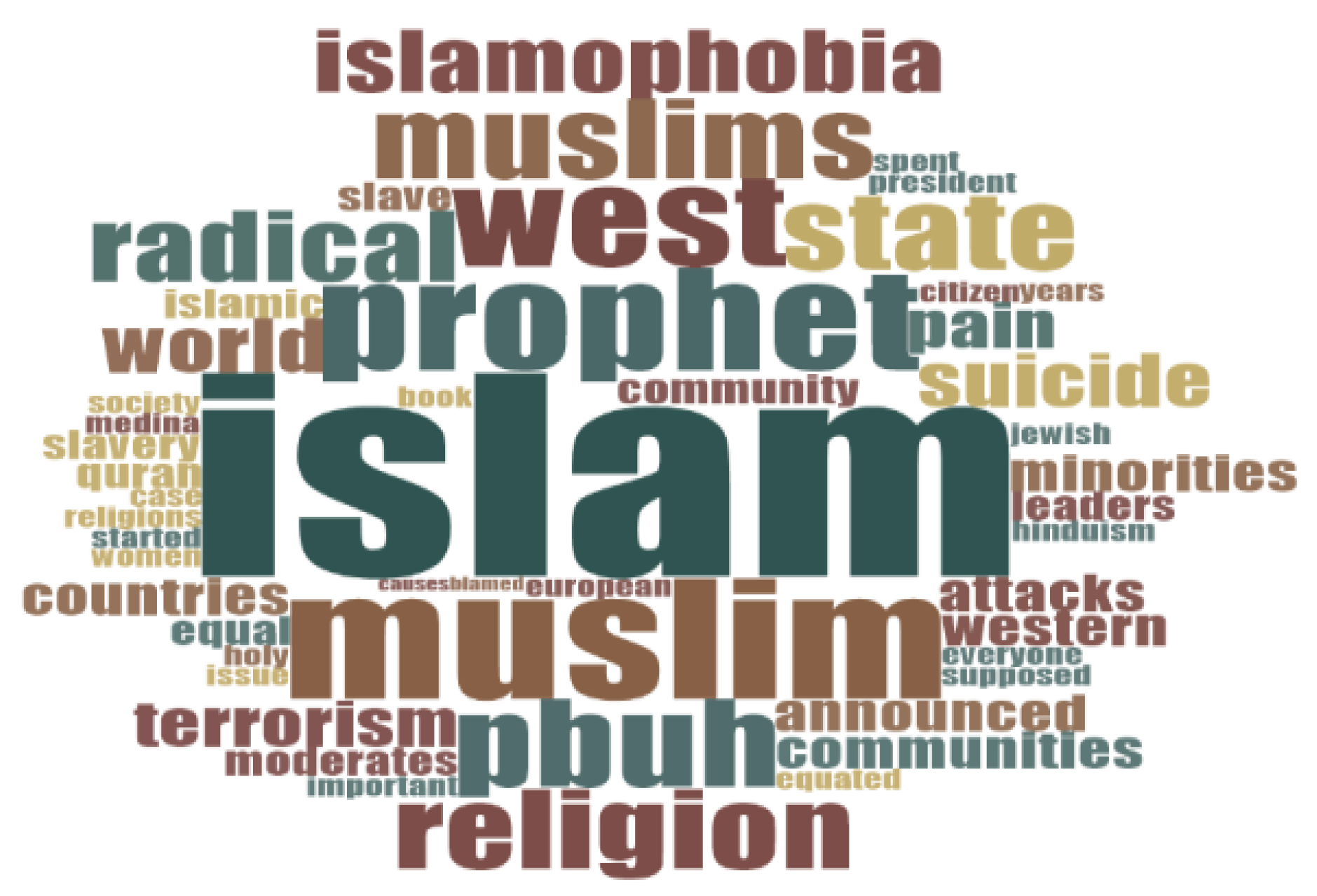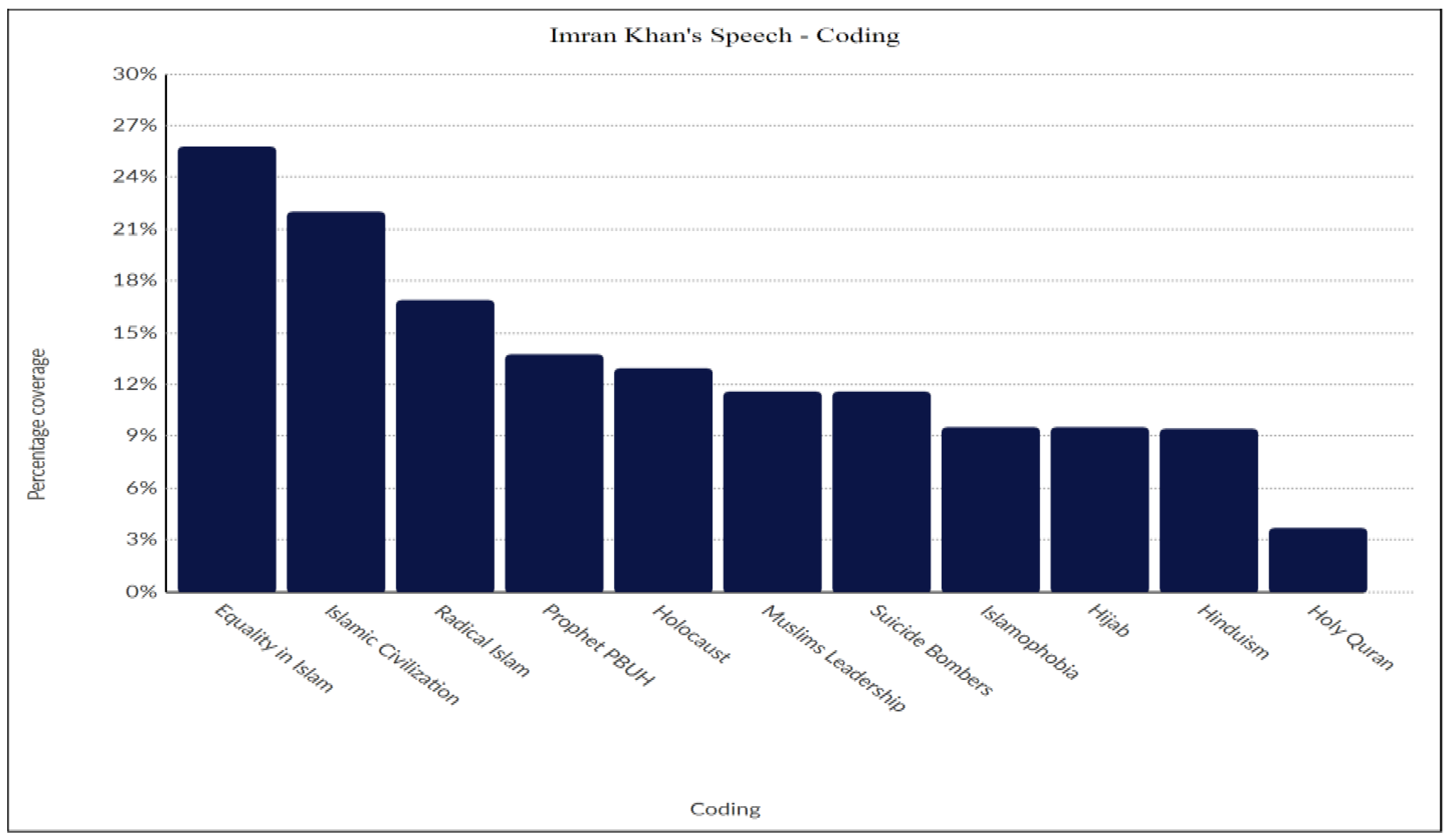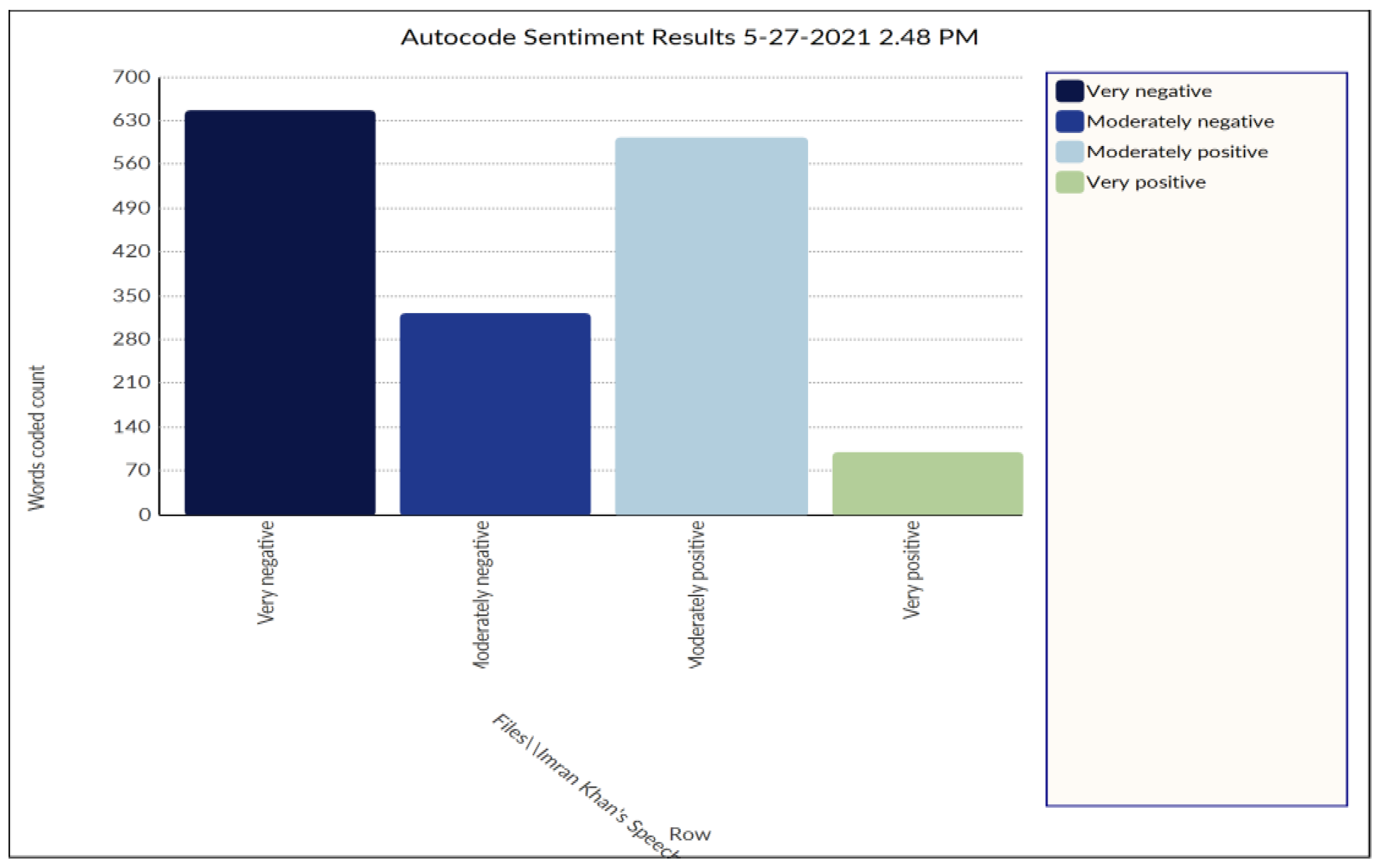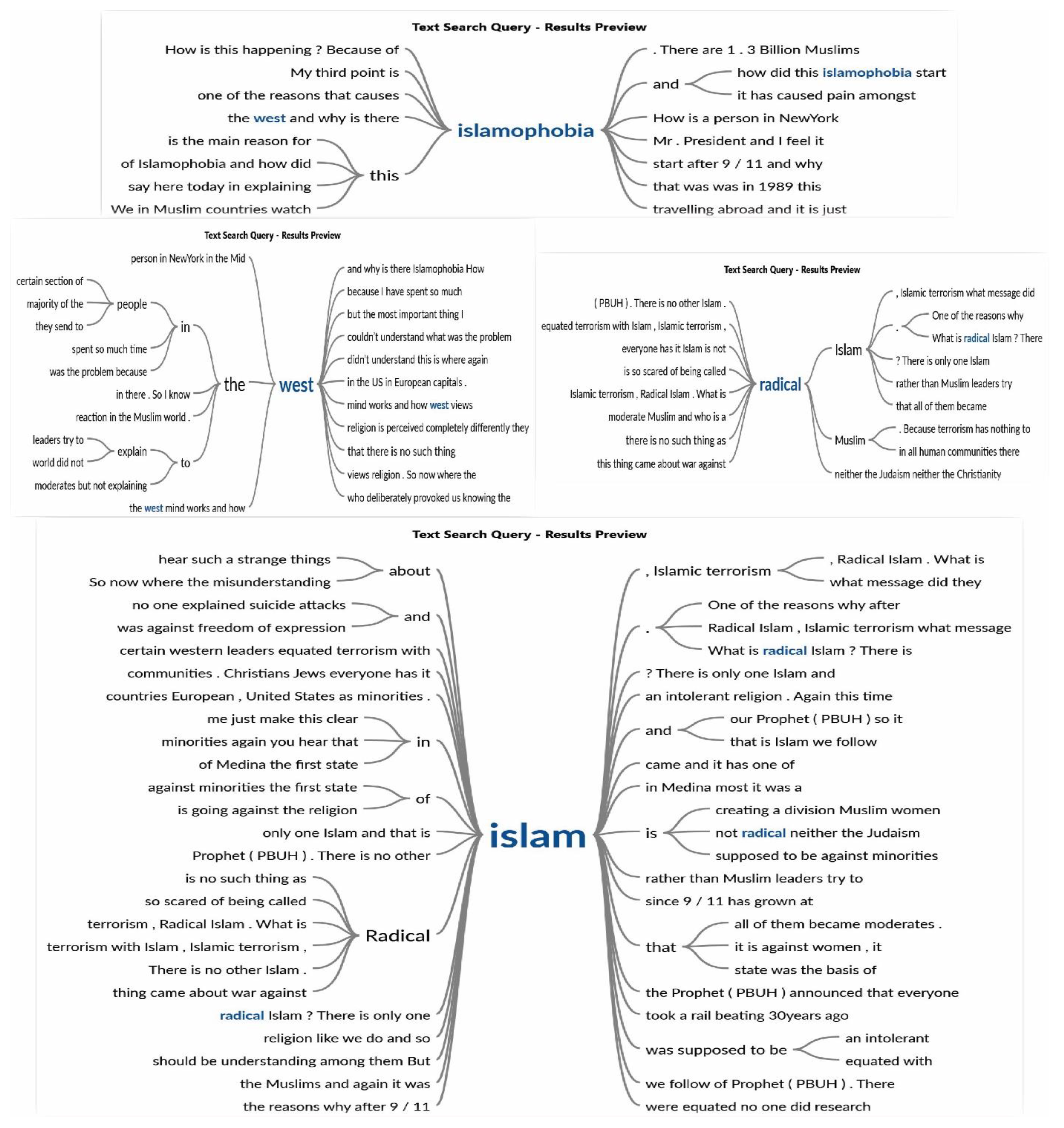Islamophobia in the West: A Critical Discourse Analysis of Imran Khan’s UNGA Speech
Abstract
:1. Introduction
1.1. Islamophobia across the World
1.2. Unpacking Islamophobia
1.3. Countering Islamophobia
1.4. Self–Other Dichotomy and Pakistan
2. Critical Discourse Analysis
3. The Ideological Square
- Emphasize positive things about “Us”
- Emphasize negative things about “Them”
- De-emphasize negative things about “Us”
- De-emphasize positive things about “Them”
4. Methodology
5. Selection and Background of Imran Khan’s Speech
6. Analysis and Findings
6.1. Computer-Assisted Analysis
6.2. Macro-Strategies Analysis
7. Conclusions
Author Contributions
Funding
Institutional Review Board Statement
Informed Consent Statement
Data Availability Statement
Conflicts of Interest
References
- Abbas, Tahir. 2019. Islamophobia and Radicalisation: A Vicious Cycle. Oxford: Oxford University Press. [Google Scholar]
- Abbas, Tahir, and Assma Siddique. 2012. Perceptions of the processes of radicalisation and deradicalisation among British-South Asian Muslims in a post-industrial city. Social Identities 18: 119–34. [Google Scholar] [CrossRef]
- Ahmed, Zahid Shahab, and Musharaf Zahoor. 2020. Impacts of the ‘War on Terror’ on the (De-)Humanization of Christians in Pakistan: A Critical Discourse Analysis of Media Reporting. Islam and Christian–Muslim Relations 31: 85–103. [Google Scholar] [CrossRef]
- Ali, Wajahat, Eli Clifton, Matthew Duss, Lee Fang, Scott Keyes, and Faiz Shakir. 2011. Fear, Inc. In The Roots of the Islamophobia Network in America. Washington, DC: Center for American Progress, Available online: https://www.americanprogress.org (accessed on 21 August 2021).
- Alietti, Alfredo, and Dario Padovan. 2013. Religious racism: Islamophobia and antisemitism in Italian society. Religions 4: 584–602. [Google Scholar] [CrossRef]
- Allen, Christopher. 2004. Justifying Islamophobia: A post-9/11 consideration of the European Union and British contexts. American Journal of Islam and Society 21: 1–25. [Google Scholar] [CrossRef]
- Allen, Christopher. 2010. Islamophobia. London: Ashgate. [Google Scholar]
- Allen, Christopher. 2020. Towards a Working Definition: Islamophobia and Its Contestation. In Reconfiguring Islamophobia. Edited by Christopher Allen. London: Palgrave. [Google Scholar]
- Amnesty International. 2012. Available online: https://www.amnesty.org/en/documents/EUR01/001/2012/en/ (accessed on 22 August 2021).
- Baker, Paul. 2006. Using Corpora in Discourse Analysis. London: A&C Black. [Google Scholar]
- Bayraklı, Enes, and Farid Hafez, eds. 2016. Introduction. In European Islamophobia Report 2015. Istanbul: SETA, pp. 5–8. [Google Scholar]
- Bazian, Hatem. 2019. Islamophobia, Trump’s Racism and 2020 Elections! Islamophobia Studies Journal 5: 8–10. [Google Scholar] [CrossRef]
- Cabot, Cyrielle. 2021. Islamist Party Tehreek-e-Labbaik Fuels Anti-France Violence in Pakistan. France 24. April 17. Available online: https://amp.france24.com/en/asia-pacific/20210417-islamist-party-tehrik-e-labbaik-fuels-anti-france-violence-in-pakistan (accessed on 12 March 2022).
- Carr, James, and Amanda Haynes. 2015. A Clash of Racializations: The Policing of ‘Race’ and of Anti-Muslim Racism in Ireland. Critical Sociology 41: 21–40. [Google Scholar] [CrossRef]
- Cervi, Laura. 2020. Exclusionary Populism and Islamophobia: A Comparative Analysis of Italy and Spain. Religions 11: 516. [Google Scholar] [CrossRef]
- Cesari, Jocelyn. 2011. Islamophobia in the West: A comparison between Europe and the United States. In Islamophobia: The Challenge of Pluralism in the 21st Century. Edited by John Esposito and Ibrahim Kalın. Oxford: Oxford University Press, pp. 21–42. [Google Scholar]
- YouGov. 2019. Western/MENA Attitudes to Religion Portray a Lack of Faith in Common Values. YouGov. February 3. Available online: https://yougov.co.uk/topics/international/articles-reports/2019/02/03/westernmena-attitudes-religion-portray-lack-faith- (accessed on 27 August 2021).
- Dunn, Kevin Ms, Rosalie Atie, Virginia Mapedzahama, Mehmet Ozalp, and Adem F. Aydogan. 2015. The Resilience and Ordinariness of Australian Muslims: Attitudes and Experiences of Muslims Report. Penrith: Western Sydney University. [Google Scholar]
- Elahi, Farah, and Omar Khan, eds. 2017. Islamophobia: Still a Challenge for Us All. London: Runnymede Trust. [Google Scholar]
- Ergül, Ergin. 2017. Islamophobia and The Counter-Terrorism Strategies. Mecca: Independent Permanent Human Rights Commission. [Google Scholar]
- Fairclough, Norman. 2013. Critical Discourse Analysis: The Critical Study of Language. London: Routledge. [Google Scholar]
- Garner, Steve, and Saher Selod. 2015. The racialization of Muslims: Empirical studies of Islamophobia. Critical Sociology 41: 9–19. [Google Scholar] [CrossRef]
- Gregory, Shaun. 2008. The Christian Minority in Pakistan: Issues and Options. Pakistan Security Research Unit Brief. Bradford: University of Bradford (UK). [Google Scholar]
- Gregory, Shaun. 2012. Under the shadow of Islam: The plight of the Christian minority in Pakistan. Contemporary South Asia 20: 195–212. [Google Scholar] [CrossRef]
- Guardian News and Media. 2019. Boris Johnson’s Burqa Comments ‘Led to Surge in Anti-Muslim Attacks’. The Guardian. September 1. Available online: https://www.theguardian.com/politics/2019/sep/02/boris-johnsons-burqa-comments-led-to-surge-in-anti-muslim-attacks (accessed on 25 August 2021).
- Huntington, Samuel. 1996. The Clash of Civilizations and the Remaking of World Order. New York: Simon and Schuster. [Google Scholar]
- Iqbal, Zafar. 2010a. Islamophobia or Islamophobias, towards developing a process model. Islamic Studies 49: 81–101. [Google Scholar]
- Iqbal, Zafar. 2010b. Understanding Islamophobia: Conceptualizing and measuring the construct. European Journal of Social Sciences 13: 574–90. [Google Scholar]
- Kaya, Ayhan. 2018. Right-wing populism and Islamophobism in Europe and their impact on Turkey–EU relations. Turkish Studies 21: 1–28. [Google Scholar] [CrossRef] [Green Version]
- Kelley, Michael. 2013. This Mind-Boggling Profile of Osama Bin Laden Came Out Exactly 20 Years Ago Today. New York: Business Insider, December 6. [Google Scholar]
- La Capra, Da. 1989. Violence, justice, and the force of law. Cardozo Law Review 11: 1065. [Google Scholar]
- Lambert, Robert, and Jonathan Githens-Mazer. 2010. Islamophobia and anti-Muslim hate crime: UK case studies. Islamophobia and Anti-Muslim. 115. Available online: https://lemosandcrane.co.uk/resources/Islamophobia_and_Anti-Muslim_Hate_Crime.pdf (accessed on 25 August 2021).
- Lean, Nathan. 2019. The debate over the utility and precision of the term “Islamophobia”. In The Routledge International Handbook of Islamophobia. Edited by Irene Zempi and Imran Awan. London: Routledge. [Google Scholar]
- Love, Erik. 2017. Islamophobia and Racism in America. New York: NYU Press. [Google Scholar]
- Mamdani, Mahmood. 2004. Good Muslim, Bad Muslim. America, the Cold War and the Roots of Terror. New York: Pantheon Books. [Google Scholar]
- Mazid, Bahaa-Eddin M. 2008. Cowboy and misanthrope: A critical (discourse) analysis of Bush and bin Laden cartoons. Discourse and Communication 2: 433–57. [Google Scholar] [CrossRef]
- Mullet, Dianna R. 2018. A General Critical Discourse Analysis Framework for Educational Research. Journal of Advanced Academics 29: 116–42. [Google Scholar] [CrossRef]
- Munir, Imran. 2002. The Consequences of Fundamentalism on Pakistani Media. Doctoral dissertation, School of Communication/Simon Fraser University, Burnaby, BC, Canada. [Google Scholar]
- Nusrat, Aasia, Sardaraz Khan, and Ms Shaista Shehzadi. 2020. Critical Discourse Analysis of Imran Khan Dharna Speeches in Socio-Political Perspective. SJESR 3: 9–19. [Google Scholar] [CrossRef]
- Rana, Junaid. 2007. The Story of Islamophobia. Souls: A Critical Journal of Black Politics, Culture, and Society 9: 148–61. [Google Scholar] [CrossRef]
- Reilly, James. 1981. Western Media and Islam. Journal of Palestine Studies 11: 161–64. [Google Scholar] [CrossRef]
- Rehman, Khalil Ur, Farooq Ahmed, Khurram Shahzad, Muhammad Azam, Saba Iram, and Shahzada Shoaib Ahmed. 2021. Persuasion and Political Discourse: A Critical Discourse Analysis of Imran Khan’s Unga Speech (74TH Session: 2019). PalArch’s Journal of Archaeology of Egypt/Egyptology 18: 1421–34. [Google Scholar]
- Reynolds, Chelsea. 2019. Building theory from media ideology: Coding for power in journalistic discourse. Journal of Communication Inquiry 43: 47–69. [Google Scholar] [CrossRef]
- Said, Edward Wadie. 1981. Covering Islam. New York: Vintage Books. [Google Scholar]
- Sayyid, S. 2014. A Measure of Islamophobia. Islamophobia Studies Journal 2: 10–25. [Google Scholar] [CrossRef]
- Sayyid, S., and AbdoolKarim Vakil. 2010. Thinking through Islamophobia: Global Perspectives. London: C. Hurst. [Google Scholar]
- Steuter, Erin, and Deborah Wills. 2010. ‘The vermin have struck again’: Dehumanizing the enemy in post 9/11 media representations. Media, War & Conflict 3: 152–67. [Google Scholar] [CrossRef]
- Sultan, Khalid. 2016. Linking Islam with terrorism: A review of the media framing since 9/11. Global Media Journal: Pakistan Edition 9: 1–10. [Google Scholar]
- Tabassum, Mehnaz, Sayed Kazim Shah, and Muhammad Bilal. 2013. A Critical Discourse Analysis of the Left and Right Wing Ideologies in Pakistani English Newspaper Editorials. Journal of Education and Practice 4: 72–78. [Google Scholar]
- van Dijk, Teun A. 1998. Ideology: A Multidisciplinary Approach. Thousand Oaks: Sage. [Google Scholar]
- van Dijk, Teun A. 2004. Politics, Ideology and Discourse. Available online: https://www.discourse-in-society.org/teun.html (accessed on 26 August 2021).
- van Dijk, Teun A. 2006. Discourse and manipulation. Discourse & Society 17: 359–83. [Google Scholar]
- Waikar, Prashant. 2018. Reading islamophobia in hegemonic neoliberalism through a discourse analysis of Donald Trump’s narratives. Journal of Muslim Minority Affairs 38: 153–78. [Google Scholar] [CrossRef]





Publisher’s Note: MDPI stays neutral with regard to jurisdictional claims in published maps and institutional affiliations. |
© 2022 by the authors. Licensee MDPI, Basel, Switzerland. This article is an open access article distributed under the terms and conditions of the Creative Commons Attribution (CC BY) license (https://creativecommons.org/licenses/by/4.0/).
Share and Cite
Javaid, M.; Khan, M.H.; Kaur, S.; Qazalbash, F. Islamophobia in the West: A Critical Discourse Analysis of Imran Khan’s UNGA Speech. Religions 2022, 13, 284. https://doi.org/10.3390/rel13040284
Javaid M, Khan MH, Kaur S, Qazalbash F. Islamophobia in the West: A Critical Discourse Analysis of Imran Khan’s UNGA Speech. Religions. 2022; 13(4):284. https://doi.org/10.3390/rel13040284
Chicago/Turabian StyleJavaid, Meesam, Mohsin Hassan Khan, Surinderpal Kaur, and Farwa Qazalbash. 2022. "Islamophobia in the West: A Critical Discourse Analysis of Imran Khan’s UNGA Speech" Religions 13, no. 4: 284. https://doi.org/10.3390/rel13040284
APA StyleJavaid, M., Khan, M. H., Kaur, S., & Qazalbash, F. (2022). Islamophobia in the West: A Critical Discourse Analysis of Imran Khan’s UNGA Speech. Religions, 13(4), 284. https://doi.org/10.3390/rel13040284






